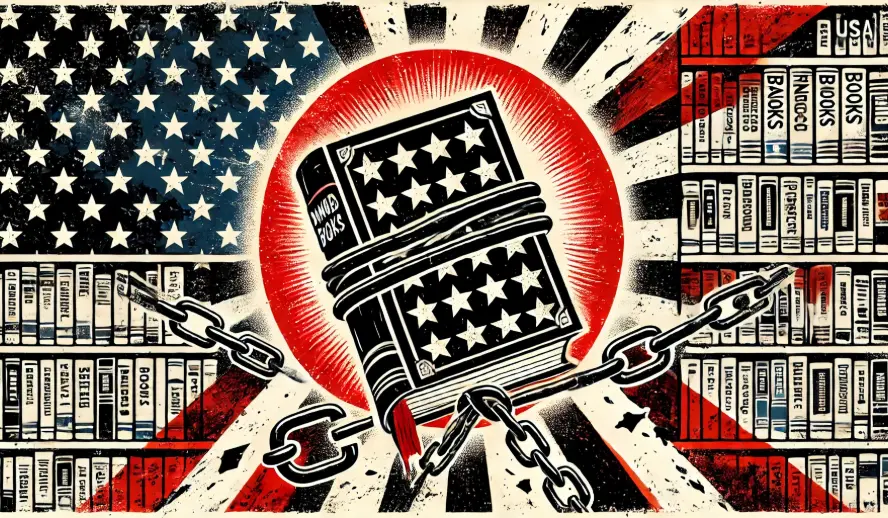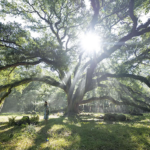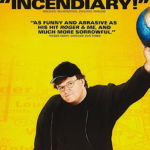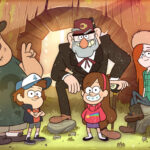Table of Contents
These Are Not the First Book Bans in US History
Book banning is not a new or even irregular phenomenon. According to the American Library Association (ALA), an average of 420 challenges to ban books were issued each year between 2001 and 2018, and the first book banned in the US was banned over a century before the United States even earned their independence. New English Canaan, Jacob Frederick Stam’s incendiary critique of Puritan life in the colonies, was banned shortly after its publication in 1637. In this case, banning meant seizure and destruction of the book’s printings. Today, banning takes the form of restricted access.
You can find lists online of the most challenged books in the US in recent history, and you’ll likely recognize a lot of them. The Harry Potter series, The Perks of Being a Wallflower, The Absolutely True Diary of a Part-Time Indian, I Know Why the Caged Bird Sings, and Of Mice and Men, for example, are recurring titles. However startling it may be that people still fear Harry Potter, its presence on the banned list is not new or unusual.
Things to do:
- Subscribe to The Hollywood Insider’s YouTube Channel, by clicking here.
- Limited Time Offer – FREE Subscription to The Hollywood Insider
- Click here to read more on The Hollywood Insider’s vision, values and mission statement here – Media has the responsibility to better our world – The Hollywood Insider fully focuses on substance and meaningful entertainment, against gossip and scandal, by combining entertainment, education, and philanthropy.
What is unusual is the number and nature of challenges and bans in the past year. PEN America, a nonprofit founded in 1922 to defend freedom of expression, has observed a massive spike in both, and a low standard of reviewing practices that make these bans particularly disconcerting. Before understanding what makes the bans even worse than the norm, it’s useful to have a point of comparison, so we’ll start with a brief explanation of how book bans work in the US.
How to Ban a Book (Though I Don’t Recommend It)
Anyone can challenge a book’s presence in a library. All it takes is walking up to the librarian at the front desk and naming a title that you feel shouldn’t be on the shelves. The librarian can then remove the book immediately, or require a formal challenge that involves filling out a form. More often than not the librarian will not remove the book, or at least call for a hearing, but the “anyone” who can challenge a book can be a group, or even a school board. When a librarian has to face a collective that may have influence over their livelihood, things get trickier.
WATCH THE TRAILER of the Film and the Revolution: ‘Can I Go Home Now?’
The Children Around the World Continue to Ask the question
If a challenge is successful, access to the book will be restricted in one of a variety of ways. In a public library, banning translates to removal of the book, or making it available only by request and only to adults. Most challenges, however, are issued to school districts, where books can be banned from curricula, banned from age-specific libraries (i.e. the middle-school library, but not the high-school library), or banned entirely from library shelves. PEN America also includes in its count books that are temporarily removed while being investigated, as this restriction to access effectively bans a book, even if only for a limited window of time.
That is, in brief, how book banning works. You might wonder when/how book banning is legal. How does that align with the First Amendment? Let’s get into it.
Related article: – Want GUARANTEED SUCCESS? Remove these ten words from your vocabulary| Transform your life INSTANTLY
Related article- A Tribute To The Academy Awards: All Best Actor/Actress Speeches From The Beginning Of Oscars 1929-2019
What About the First Amendment?
Attempts to completely ban a book from a library are rarely successful in the long term, even less so when taken to court. In one of the most notable cases to reach the Supreme Court, Island Trees School District v. Pico (1982), the Justices issued a plurality opinion that restricted school districts from removing books from libraries due to a distaste for, or disagreement with, ideas contained in the book. However, it is legal to remove books if they can reasonably be defended as obscene or inappropriate for a given age group, and community standards can be taken into account to some extent.
In most court cases involving book bans, judges side with libraries and against those who would have books removed from them. This is because the books in question are rarely defensibly obscene. School librarians in particular, typically follow publisher’s suggestions for appropriate age groups. Nabokov’s Lolita, for example, which is not obscene but certainly not appropriate for young children, hardly ever faces a challenge because it and books like it are not being disseminated to young people. Books like Slaughterhouse-Five and Catch-22 have more often been presented in district or federal courts. Each time, the courts have found that challenges against the books in question are ideologically based or enacted with insufficient understanding of the books themselves, and that a ban would infringe upon the students’ First Amendment rights.
Related article: EVOLUTION: Every Ryan Gosling Role From 1995 to 2020, All Performances Exceptionally Poignant
Related article: EVOLUTION: Every Henry Cavill Role From 2001 to 2021, All Performances Exceptionally Poignant
Related article: All Best Actor/Actress Speeches From The Beginning Of Oscars 1929-2019 | Hollywood Insider
Related article: The 2022 NAACP Image Awards: Full List of Nominees, A History of the Ceremony, and How to Vote
In an effort to protect those rights without having to take each individual case of book challenging to court, both the ALA and NCAC (National Coalition Against Censorship) have developed guidelines for reviewing challenges that include creating a well-rounded committee of reviewers, leaving aside subjective viewpoints as much as possible, and demonstrating familiarity with the book as a whole. These guidelines have a successful history to recommend them, and the NCAC even includes examples of procedures that specific school districts have drawn up with the guidelines in mind.
Fahrenheit 2022
And now, the reason for the sensational title. Between July 1, 2021 and March 31, 2022, PEN America has counted “1,586 instances of individual books being banned [from schools], affecting 1,145 unique titles.” Given the average from ALA reports spanning 2001-2018 (420 per year), that means books are being banned from schools at about four times the typical rate.
Related article: Understanding the Star Wars Timeline
Related article: A Tribute to Francis Ford Coppola: One of Cinema’s Unforgettable Directors | ‘Megalopolis’, ‘The Godfather’ & More
Related article: #metoo Revolution: Powerful Questions That Need Answers
Related article: FACT-CHECKED Series: Timothee Chalamet and 32 Facts about The Young Superstar
In the states where the majority of these bans are happening–Texas, Pennsylvania, and Florida most prominent among them–best practices are being shirked in favor of immediacy. Over 90% of the bans have gone forth without anyone filing a formal challenge, and a considerable amount of these schools have eschewed their own policies by forming ad hoc reconsideration committees or just lifting books from shelves without a reconsideration process at all. A lot of books are unavailable pending investigation, which also falls out of line with best practices. Similar suspension practices have been ruled against in court, most sensationally in A Quantity of Books v. Kansas (1964). In that case, the Kansas Supreme Court issued a warrant permitting the seizure of 59 book titles, allowing police to confiscate them from businesses, all without an official obscenity hearing. When the case reached the Supreme Court, the Justices issued a plurality opinion that found the process by which the books were seized unconstitutional, and that seizure prior to a hearing endangers the right of the public to “unobstructed circulation of nonobscene books.”
Perhaps the most concerning trend from the past year has to do with the contents of the books being banned. The vast majority of books on the list either deal heavily with race, or feature LGBTQ+ characters. This trend, especially of banning racially aware books, is not entirely new. Books by Toni Morrison and Maya Angelou, in particular, have seen more than their fair share of bans, as has To Kill a Mockingbird. Recently, however, school districts have taken to banning several titles at once, or banning student access to articles that recommend lists of books having to do with racism or anything related to LGBTQ+ issues.
Related article: Top 10 South Park Characters | Who Makes the Cut? Kenny, Chef, Butters, Towelie, Eric?
Related article: In-Depth Analysis | The Unexpected Queerness of ‘Bob’s Burgers’: Why the Show is an Animated Ally
Related article: HBO Max Celebrates Queer Love in the Face of Tragedy in Latest LGBTQ Masterpiece ‘It’s a Sin’
The typical move is to ban a book about race or that features queer characters on the grounds of being sexually explicit, violent, or profane. Books like Out of Darkness by Ashley Hope Peréz and All American Boys by Jason Reynolds and Brendan Kiely, for example, have met with bans for containing violence, profanity, or drug use. Books like Gender Queer: A Memoir by Maia Kobabe, meanwhile, have faced bans for being sexually explicit. This is not the first time parents and schools have attempted to censor material like this. Here is a brief series of classics that have been challenged for similar reasons: Brave New World, One Flew Over the Cuckoo’s Nest, Invisible Man, The Great Gatsby, A Separate Peace. Again, that’s just a sample.
Yes, It’s Political
Gender Queer: A Memoir serves as an excellent example in demonstrating how these bans have targeted racially charged and queer stories, as it contains a visual depiction of oral sex. That seems like decent grounds for being considered obscene, until you consider the contents of those aforementioned classics which have all found their way back to schools. Brave New World contains an orgy, both One Flew Over the Cuckoo’s Nest and Invisible Man contain rape scenes. Even Romeo and Juliet, which is usually less controversial than those titles, contains an abundance of sexually charged language including Juliet’s infamous anticipation of an orgasm (“Come, gentle night…”). Attempts to censor anything sexual or violent, despite repeatedly failing, are not unusual, but it is no coincidence that this massive wave of bans targets, almost exclusively, racially charged and queer stories. The reasoning remains the same, it just happens to be the case that Black and queer authors are challenged far more than their contemporaries.
Related article: In-Depth Analysis | The Unexpected Queerness of ‘Bob’s Burgers’: Why the Show is an Animated Ally
Related article: EVOLUTION: Every Chris Evans Role From 1997 to 2020, All Performances Exceptionally Poignant
Related article: A Tribute to Keith Haring: The Magnificent Artist and LGBTQ Icon
Using tired excuses that attempt to dodge the clearly ideological reasoning behind these bans, school districts, political representatives, and parents, are attempting to censor books because they disagree with them, not because they are obscene.
Unfortunately, the bans have come hand-in-hand with an excessive amount of educational gag orders and attempts by various schools to allow parents to watch video footage of classes and file complaints based on what they find disagreeable. Signs of Critical Race Theory are, unsurprisingly, cited as justification for parents to play the role of Big Brother, and it doesn’t seem at all coincidental that all this fear-mongering has led to biographies being banned. Books on the lives of James Baldwin and Nelson Mandela are among those that have been targeted. Once again, something as ludicrous as banning the story of James Baldwin’s life can only be the result of politically motivated endeavors to censor anything queer or racial (especially Black). I wish I could say otherwise.
Related article: LGBTQ+ Representation in Film/TV: From The First Romantic Film in 1919 Based On A Gay Love Story To Where We Must Go
Related article: The Rise and Journey of Lisa Vanderpump: Reality Television Queen and Long-Time Activist
These bans will likely amount to little more than a short-lived campaign to express political dissent, and the majority that go to trial will likely be deemed unconstitutional if Supreme Court precedents are maintained, but I can’t predict the future. What I can do is speak out against censorship. These bans do not belong in a free, democratic nation.
By Kevin Hauger
Click here to read The Hollywood Insider’s CEO Pritan Ambroase’s love letter to Cinema, TV and Media. An excerpt from the love letter: The Hollywood Insider’s CEO/editor-in-chief Pritan Ambroase affirms, “We have the space and time for all your stories, no matter who/what/where you are. Media/Cinema/TV have a responsibility to better the world and The Hollywood Insider will continue to do so. Talent, diversity and authenticity matter in Cinema/TV, media and storytelling. In fact, I reckon that we should announce “talent-diversity-authenticity-storytelling-Cinema-Oscars-Academy-Awards” as synonyms of each other. We show respect to talent and stories regardless of their skin color, race, gender, sexuality, religion, nationality, etc., thus allowing authenticity into this system just by something as simple as accepting and showing respect to the human species’ factual diversity. We become greater just by respecting and appreciating talent in all its shapes, sizes, and forms. Award winners, which includes nominees, must be chosen on the greatness of their talent ALONE.
I am sure I am speaking for a multitude of Cinema lovers all over the world when I speak of the following sentiments that this medium of art has blessed me with. Cinema taught me about our world, at times in English and at times through the beautiful one-inch bar of subtitles. I learned from the stories in the global movies that we are all alike across all borders. Remember that one of the best symbols of many great civilizations and their prosperity has been the art they have left behind. This art can be in the form of paintings, sculptures, architecture, writings, inventions, etc. For our modern society, Cinema happens to be one of them. Cinema is more than just a form of entertainment, it is an integral part of society. I love the world uniting, be it for Cinema, TV, media, art, fashion, sport, etc. Please keep this going full speed.”
More Interesting Stories From The Hollywood Insider
– Want GUARANTEED SUCCESS? Remove these ten words from your vocabulary| Transform your life INSTANTLY
– A Tribute to Martin Scorsese: A Complete Analysis of the Life and Career of the Man Who Lives and Breathes Cinema
– Do you know the hidden messages in ‘Call Me By Your Name’? Find out behind the scenes facts in the full commentary and In-depth analysis of the cinematic masterpiece
– A Tribute To The Academy Awards: All Best Actor/Actress Speeches From The Beginning Of Oscars 1929-2019 | From Rami Malek, Leonardo DiCaprio To Denzel Washington, Halle Berry & Beyond | From Olivia Colman, Meryl Streep To Bette Davis & Beyond
– In the 32nd Year Of His Career, Keanu Reeves’ Face Continues To Reign After Launching Movies Earning Over $4.3 Billion In Total – “John Wick”, “Toy Story 4”, “Matrix”, And Many More










